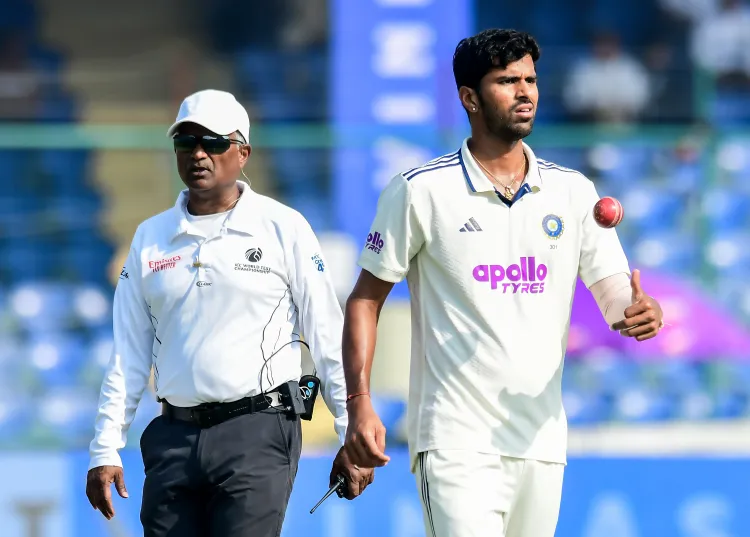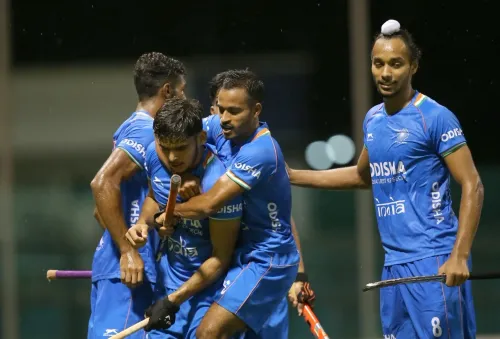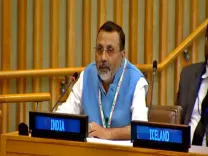Is It Encouraging to Take 20 Wickets on a Slow Pitch? Washington Sundar Responds!

Synopsis
Key Takeaways
- Collective Effort: The Indian bowling unit's teamwork led to taking 20 wickets.
- Patience Required: Bowlers needed to be patient on a slow pitch.
- Standout Performers: Kuldeep Yadav and Jasprit Bumrah excelled.
- Key Partnership: Campbell and Hope's century partnership was pivotal.
- Resilience: The team's adaptability was crucial for success.
New Delhi, Oct 13 (NationPress) India’s off-spin bowling all-rounder Washington Sundar praised the unified bowling performance that enabled the home side to capture 20 wickets on a sluggish and lifeless pitch at the Arun Jaitley Stadium, describing it as ‘very encouraging’.
On the fourth day, Kuldeep Yadav backed his first-innings performance of 5-82 with three wickets in the second innings, while Jasprit Bumrah also contributed three wickets to dismiss the West Indies for 390 in the final session. In a modest pursuit of 121, India ended the day at 63/1 after 18 overs.
“On a wicket like this, you need a lot of patience and to consistently hit those right areas, which is the main challenge. However, it's great to have taken 20 wickets on such a surface. All the bowlers performed exceptionally well, including the fast bowlers, who put in their utmost effort in every spell. So, it is indeed heartening, despite the slow nature of the game,” Sundar stated in the post-day press conference.
He also acknowledged the resistance from West Indies batters John Campbell and Shai Hope, who each scored centuries while forming a remarkable 177-run partnership, emphasizing that patience and perseverance were necessary to break their stand. “Honestly, Campbell and Hope played excellently. They capitalized on their opportunities. Once the field was spread, they displayed impressive game sense. Both batted superbly,” he remarked.
“Our conversation focused on being patient and delivering quality deliveries consistently, regardless of the circumstances. The outcome is beyond our control, especially on such a wicket. However, our aim was to bowl well consistently and remain fresh for each spell. I believe we all executed that effectively,” Sundar added.
It is quite uncommon for Tests in India to extend into the fifth day, with the home bowlers enduring strenuous periods under the bright New Delhi sky. They were on the field for precisely 200 overs since mid-day two, illustrating the physical demands of Test cricket on pitches that offer little assistance to bowlers.
“We must be in excellent physical condition and stay on top of our game. In Test cricket, one expects matches to go to the fifth day and to challenge you in every conceivable way. So, it's not entirely surprising in this format. Yes, it’s thrilling to participate in this format and showcase high-quality cricket, especially at this level,” Sundar remarked.
He also reflected on lessons learned from the drawn series against England earlier this year, where India's bowlers faced long spells and significant fielding demands. “The England series truly highlighted what it feels like to be on the field for five days.”
“In England, we fielded for around 180-200 overs in every game. So, this experience is not entirely new for us. Many would have preferred if the game concluded today. However, Jaiswal put forth his best effort. On another day, we would have certainly wrapped it up today,” he mentioned.
While some critics believed the Indian bowlers could have exerted more pressure on the West Indies batters, particularly the last wicket pair of Justin Greaves and Jayden Seales, Sundar insisted that the hosts attempted to vary their angles and lines to dismiss them swiftly.
“We made several adjustments based on the batsman at the crease. For certain batsmen, we aimed to bowl a bit wider and target the rough. For others, we remained straight to bring the stumps into play,” he explained.
“It pertains to the characteristics of the batsmen out there, and we aimed to exploit their weaknesses, making them face as many deliveries as possible to eventually claim wickets. Overall, I believe we maintained patience and bowled many quality deliveries throughout the match. It was a commendable effort from all of us,” he added.
Sundar further credited Kuldeep Yadav's wrist spin, which earned him eight wickets, for making a significant impact on the slow pitch. “He bowled exceptionally well in both innings, targeting the right areas effectively. Being a wrist spinner, he managed to extract some purchase, which definitely aided our cause.”
“Nonetheless, I believe every bowler performed admirably. Even the quick bowlers gave their all. In every spell, they came out and delivered excellently. So, as I mentioned, it's truly heartening to have taken 20 wickets in this manner,” he concluded.
Assistant coach Ryan ten Doeschate mentioned that they had requested a slower pitch and were not surprised by its low bounce and minimal turn. In response to this, Sundar chose to commend the variety of conditions the Indian team encounters in Tests.
“Every venue is quite different, isn’t it? This could be described as a typical Delhi wicket, characterized by minimal bounce and not much turn throughout the game. Different venues present unique challenges, and that’s the beauty of this format,” he said.
“We play in various conditions, whether at home or abroad. Naturally, all those conditions and the opposition challenge our skill sets, and that’s what makes this format so special. We continue to adapt, assess what’s required under those circumstances, and strive to remain at the top of our game to contribute meaningfully for the team,” he elaborated.
It has been a Test match where Sundar did not get the opportunity to bat, as India declared their first innings at 518/5, leading to a greater reliance on his off-spin. For someone like Nitish Kumar Reddy, who is being developed as an all-rounder in home Tests, not getting to bowl at all during the match has raised questions.
Sundar concluded by expressing his preparedness to bat whenever the opportunity arises, and emphasized that being an all-rounder offers more ways to impact the team in a match. “It’s truly a blessing to be an all-rounder because you’re always part of the game, either with the ball or the bat.”
“You have a fantastic opportunity to influence the team positively with both skill sets and ultimately contribute to winning the match for the country. I am incredibly grateful for the skills I have been blessed with. In Test cricket, having as many all-rounders as possible is advantageous.”
“Historically, if you examine the teams that have excelled in Test cricket over the years, they have typically featured quality all-rounders. I believe we have some remarkable all-rounders in our squad as well. Therefore, it’s an opportunity to either make a significant contribution with the bat or ball as the situation demands and to ultimately secure victory for the nation,” he concluded.









